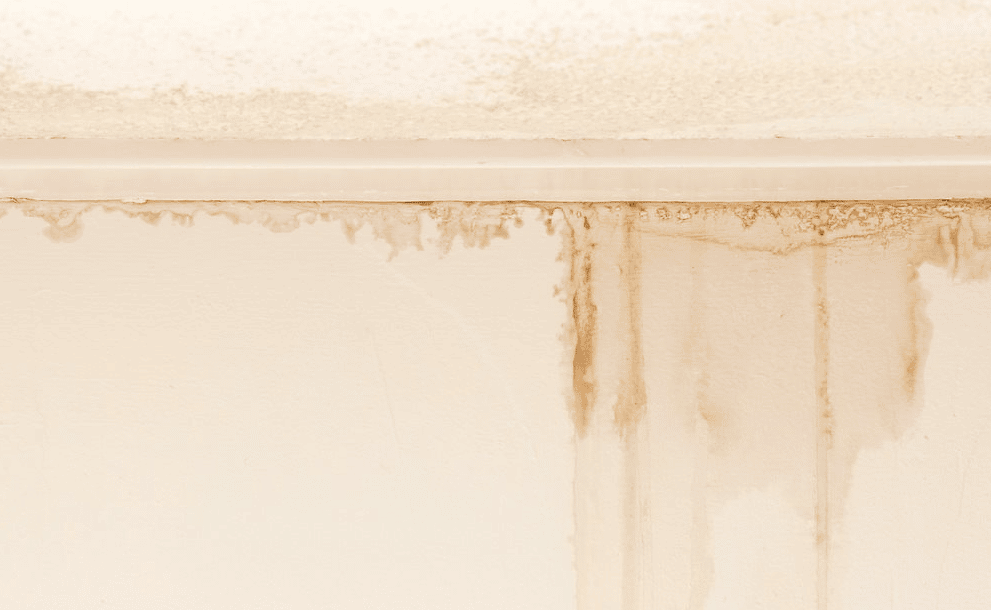Finding a roof leak can be very disheartening, especially if it’s newly installed. It’s not something most people even think about until it’s happening to them, meaning they often don’t know what to do next. We hope to clear this up below by explaining what steps to take when finding a leak in your home.

Signs of a leak
If you find signs of a leak, your first priority should be to call a repair service, no matter how small or large the evidence. If your roof is leaking water, it could be a sign of a much larger problem, which needs to be addressed immediately. It will not fix itself or go away with time.
Homeowners can sometimes ignore what they consider to be a small problem with dampness, only to discover it has become a dripping mess in a few months’ time, causing permanent damage to the structure of your home and demanding costly repairs, so it is best to never take risks when you spot any of the following signs:
• Sagging: certain kinds of roofing that are inundated with damp can disintegrate quickly, going from being taught to a floppy, wet mess which looks a bit like a growth or bulge. The area will be blotchy and dark if fresh, or discoloured if left for longer. Ceiling tiles like the ones found in industrial buildings are common for this trait, but yours at home could also exhibit this behaviour depending on their material.
• Dark spots: although the affected area might not be displaced in any way, the new appearance of brown, sometimes mouldy, patches on your interior walls are very telling of an issue with damp. If these have appeared suddenly and are rapidly spreading, particularly after a spell of wet weather, there is a likelihood that there is water pooling inside your walls.
• Wetness or dripping: this is the most obvious sign of a problem – when the water makes itself visible. If you look closely at where the drips are coming from, you might find a small crack or hole where daylight is shining through, indicating that there is a fault with the tiling on your exterior roofing. Your walls will be damp and cold to the touch, too.
How to contain a leak
After you have called for a quick repair service to come to your aid, your next task should be to contain any water dripping from the site. Find a large plastic or glass container and place it underneath where the water is falling. This could require some trial and error, but as soon as you catch a droplet in the container, you know you have positioned it in the right place.
Next, mop up all the water that you have not been able to contain. Leaving a puddle on the floor can lead to other problems, particularly if it’s left on vinyl or wooden tiles which can be lifted if water becomes trapped underneath them. If the sound of the dripping water is infuriating, take a board and prop it up inside your container. This ensures that the water will hit the board before running down into the collected liquid, sparing you from the repetitive dripping noise.
If water has accumulated in a bulge, puncture it with an old screwdriver. Making a hole in your own roof might sound strange, but it is a better alternative than leaving water to fester inside as the added pressure, if strong enough, can cause your entire roof to collapse. Creating a second, or larger, outlet will help the buildup to drain much easier.
What will a roofer do?
If they’re satisfied everything inside is secure for now, the first thing they’ll do is inspect your exterior. They’ll assess your roof for any signs of wear, such as loose material and wear around vents and chimneys, which could be allowing water into your house. Individually rotting or damaged shingles could also pose a problem, so if any of these do not appear to be up to scratch, they might suggest you have them replaced.
Another potential issue they’ll be on the lookout for is gutters and drains that are not handling running water properly. The pipes could be clogged, causing them to overflow and spill into gaps in your roof or walls. If this seems to be the leading cause, they’ll recommend gutter and drain cleaning and suggest a regular maintenance schedule.
What we can do
At Ware Painting Roofs, we can restore, repaint and repair damaged roofs, with all work carried out by a team of experienced roofing experts. If you have detected a leak and want some help, we specialise in finding and fixing the source of the problem, so you can live in a dry home for years to come.






